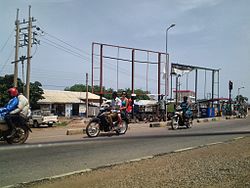|
Bolgatanga
Bolgatanga (Frafra: Bɔlegataŋa), colloquially known as Bolga, is a town and also the capital of the Bolgatanga Municipal and the Upper East Region of Ghana.[4][5] It share's a border to the north with Burkina Faso. Bolgatanga is 161 km (100 mi) to the north of Tamale. The town lies in the Red Volta Valley (which serves as a major migration route of elephants), with the White Volta and the cliffs of the Gambaga escarpment to the south of the town forming the southern boundary of the Upper East Region.[6] As of 2021, the town has a population of about 142,509 people constituting females (74,659), representing 52.4 percent than males (67,850) constituting 47.6 percent.[7][2] Some ethnic groups who lived in large qualities in Bolgatanga are Frafra, Daghati, Akan, Ewe, and Ga-Adangbe.[3] The current mayor of the town is Rex Asanga.[8] Bolgatanga Municipal's population in 2021 was with more females (74,659), repre- senting 52.4 percent than males (67,850) constituting 47.6 percent. The Municipal occupies a land size of 334 Km2 with a population density of 418.7 persons per square kilometre. History EtymologyThe name Bolgatanga (Bolbatanga) was derived from the Gerunsi words "'Boole" Clay and "tanga" rocks. FormationHistorically, the town was located close to the Trans-Saharan trade route. Due to many trade routes crossed the Gurensi region, by the end of the 19th century the area it grew into an important trading center with marketplaces (Ayia Daa) popping up around the town. In 1910, Bolgatanga was finally connected with the rest of Ghana with the addition of a road.[9] AdministrationThe town has a mayor–council form of government. The mayor (executive chief) is appointed by the president of Ghana and approved by the town council, the Bolgatanga Municipal Assembly. The current mayor of Bolgatanga is Rex Asanga.[8] DemographicsThe majority of the town is religious, making up 97.3% of the town's population, while the biggest religions in the town are Christianity (57.6%), traditional religions (22.3%), and Islam (17.1%).[3]: 32 Majors ethnic groups who lived in Bolgatanga are Northerners, Akan, Ewe, and Ga-Adangbe.[3]: 3 Transportation There is public transportation from Bolgatanga to major cities such as Accra, Kumasi, Mim, Ahafo, Cape Coast, Sunyani, Tamale, Tema, Ho, Wa, Elubo, Aflao, and Techiman. The most popular form of intracity transport is a covered rickshaw popularly referred to as 'candoos'.[10][11] For the transportation of goods, an uncovered tricycle popularly known as 'motor king' is used. Though the use of Donkey Carts for carrying goods has been part of the life of the people of Bolgatanga it is scarce due to rapid development.[12] In 2016, an $141 million project was underway to help increase the quality of transportation of the Bolgatanga-Bawku-Pulmakom Road. Originally supposed to be completed sometime in 2018, due to some unresolved issues it was push back to late-2024.[13] Culture Bolgatanga is known as the crafts centre of the Upper East Region, with a large central market. Apart from items found elsewhere in the Upper East Region, the so-called "Bolga hats" are made and sold in Bolgatanga. Bolgatanga and its surrounding suburbs also contain the largest producers of leather goods, straw baskets, and smocks. The artists sell their works at the Bolgatanga Market, which is open every third day. There is also a museum in the town, which houses objects of historical importance of the Upper East Region.[14] GeographyBolgatanga is located in the Bolgatanga Municipal which has an area of 729 km2 (281 sq mi). The district bordered the Bongo District to the north, the Talensi and the Nabdam district towards the south and east and the Kassena-Nankana Municipal District to the west. The town's landscape is described by gentle slopes mixed with rock outcrops and uplands.[3]: 1, 3 ClimateThe town has a hot semi-arid climate (Köppen climate classification BSh), experiencing a rainy season and a dry season per year. In Gurene, these seasons are regraded as "Oone" and "Sioo". The rainy season usually spanning from May to September, while the dry season is long and ranges from November to March. Rainfall amounts are often lackluster and ranges from 800 to 1,200 mm (2.6 to 3.9 ft).[15]
EconomyThe major economic sectors of Bolgatanga are agriculture, hunting, forestry, and industry. Regrading agriculture, about 80% of the population is engaged in the sector in which some of the crops cultivated are millet, maize, guinea-corn, rice, beans, groundnuts, and sweet potatoes during the rainy season and irrigation farming of onions, tomatoes, and peppers during the dry season.[3]: 4 Human resourcesHealthcareThe primary hospital is the Bolgatanga Regional Hospital. In 2020, a rehabilitation project began consisting of a four-story building consisting of 39 apartment rooms for the hospital's staff along with other facilities. Since then, the hospital have undergone multiple renovation.[17] Education Bolgatanga LibraryThe Bolgatanga Library is a notable design of award-winning American architect J. Max Bond Jr., who was influenced by Le Corbusier. Bond lived in Ghana for four years in the 1960s. The Bolgatanga library was his first major project while working for the national construction company. The design features perforated walls and an "umbrella"-shaped roof, so the structure remains cool and well ventilated.[18] The following is a list of schools in Bolgatanga:
References
See alsoExternal links
|
||||||||||||||||||||||||||||||||||||||||||||||||||||||||||||||||||||||||||||||||||||||||||||||||||||||||||||||||||||||||||||||||||||||




